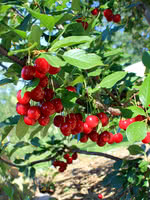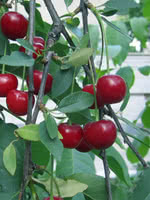Mon-Fri 9am - 5pm Mountain time
Evans Cherry vs Sour Cherry
Prunus cerasus Evans
Prunus cerasus
Evans Cherry is a cold-hardy sour cherry tree that is typically highly productive. It produces bright red, tart fruit that are well suited to fresh eating, baking, and preserves. In the spring, beautiful white flowers cover the branches, adding ornamental value.
Evans Cherry was developed in Alberta. It was rediscovered in 1976 near Edmonton, AB, by Dr. Ieuan Evans.
Sour cherries are self-fertile; however, planting with additional varieties for cross-pollination can increase yields.
Sour Cherry is cold-hardy and typically grows as a small tree. In late spring, it produces clusters of fragrant white blossoms that mature into bright red, tart fruit. Although the cherries can be eaten fresh, they are most commonly used in baking and preserves.
While not native to North America, Sour Cherry serves as a larval host plant for the Eastern Tiger Swallowtail (Papilio glaucus), a butterfly native to eastern North America.
Sour cherries are self-fertile; however, planting near additional cherry trees for cross-pollination can increase yields.
This Sour Cherry is produced from seed collected from an Evans Cherry and is not clonally reproduced.

